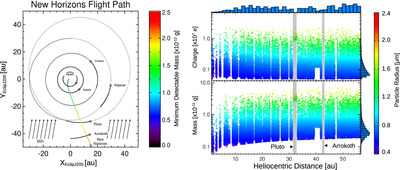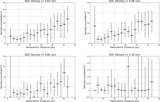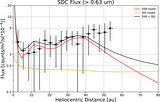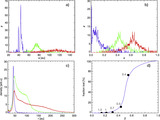Image Details

Caption: Figure 1.
Left: the flight path of the New Horizons spacecraft up through 55 au with the minimum detectable mass represented in the color scale. The decrease in spacecraft speed with increasing distance results in a higher minimum detectable mass. New Horizons is heading along the ecliptic longitude λ NH ≃ 293° compared to the ISD inflow of λ ISD = 259°, indicated by the parallel upward-pointing arrows at the bottom. Therefore, ISDs impact SDC at an angle of α ≃ 23° off of normal (Bernardoni et al. 2022). ISDs currently impact SDC at 39 km s−1 while IDPs only impact at 14 km s−1. Therefore, despite their size difference, ISD impacts can be measured and interpreted as small IDPs (Bernardoni et al. 2022). Based on the current model, ISD assumed IDP size should not exceed 0.68 μm. Right: all noncoincident data up to 2023 July 25. Each detector has an independent mass threshold. For flux and density computation a common threshold was set at r g ≥ 0.63 μm (m ≥ 2.62 × 10−12 g) such that all of the detectors provide an equal statistical contribution to the calculated flux and density (Bernardoni et al. 2022). The gray blocks represent regions of exceptionally high thresholds due to high spacecraft activity during close encounters with Pluto and Arrokoth. Other periods of missing data are due to SDC being powered off for spacecraft operational reasons.
Copyright and Terms & Conditions
© 2024. The Author(s). Published by the American Astronomical Society.







